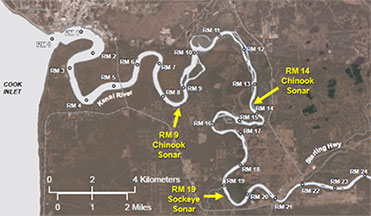
Kenai (RM 8.6) River
Overview
Kenai River Mile 8.6 - King Salmon Sonar Site

Estimating the abundance of Kenai River king salmon is a challenging task. Whereas most salmon swim close to shore where they can most easily be detected by sonar, king salmon are found at all ranges and commonly swim upstream in the deeper offshore regions of the river where it is more difficult to detect them with sonar. Estimating Kenai River king salmon abundance is further complicated by the need to separate them from sockeye and other salmon that are more abundant and migrate during the same time period.
The Kenai River king salmon site is the only project at which ADF&G uses sonar to distinguish fish by size. Since 2007, the project has been field-testing a new multibeam sonar technology known as DIDSON and working to develop techniques to more accurately assess king salmon abundance using size information taken from high-resolution images of fish. These trials have allowed the project to transition completely from split-beam to DIDSON technology starting in 2011. To further improve estimates of king salmon abundance, ADF&G has been exploring the potential for moving the site further upstream above tidal influence.
Sonar is only one of the tools that ADF&G uses to generate estimates and gauge run strength. ADF&G also relies heavily on information from non-sonar tools including inriver gillnets and sport fish creel surveys.
